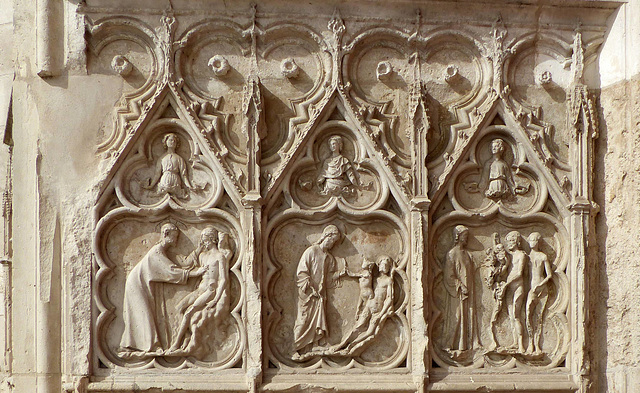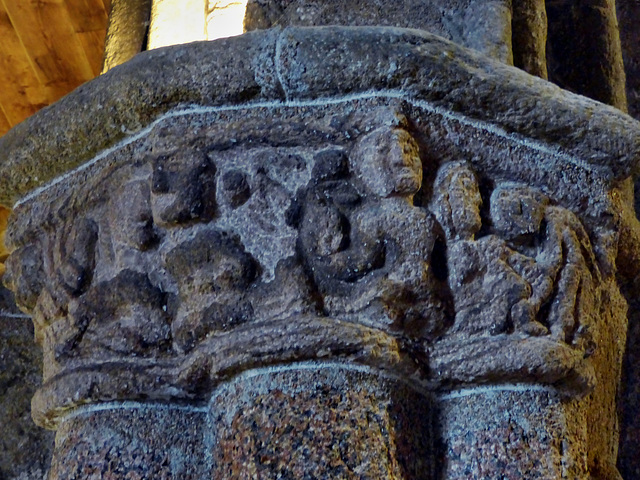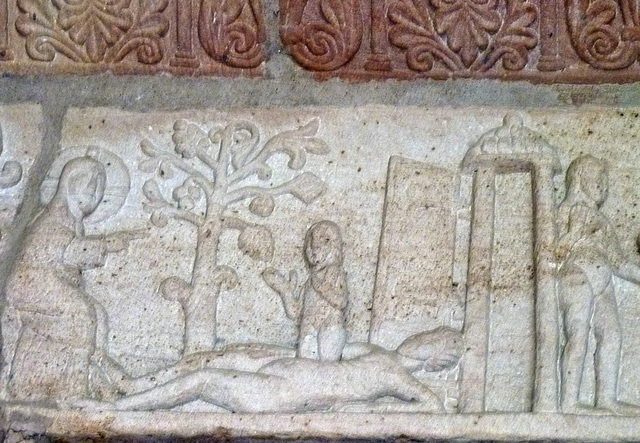
The Creation of Eve
Genesis 2:18-22
"The Lord God said, “It is not good for the man to be alone. I will make a helper suitable for him.” (....) "But for Adam no suitable helper was found. So the Lord God caused the man to fall into a deep sleep; and while he was sleeping, he took one of the man’s ribs and then closed up the place with flesh. Then the Lord God made a woman from the rib" (....)
"The Lord God said, “It is not good for the man to be alone. I will make a helper suitable for him.” (....) "But for Adam no suitable helper was found. So the Lord God caused the man to fall into a deep sleep; and while he was sleeping, he took one of the man’s ribs and then closed up the place with flesh. Then the Lord God made a woman from the rib" (....)
Auxerre - Cathédrale Saint-Étienne d'Auxerre
Auxerre was a Gallo-Roman centre, then called Autissiodorum. Here the Via Agrippa crossed the Yonne river. It became the seat of a bishop already in the 3rd century. In the 5th century, it received a cathedral.
Wine cultivations starting from the twelfth century made Auxerre a flourishing town. Auxerre suffered during the Hundred Years' War and the Wars of Religion. In 1567 it was captured by the Huguenots, and many of the Catholic edifices were damaged.
The Cathédrale Saint-Étienne is actually the 5th on the spot.
The erection started in 1215 around the same time when the building of the cathedrals in Reims and Amiens started. The church was erected over a still existing crypt from the previous building (~ 1030).
The choir was completed in 1235. The cathedral is known for the stained glass of the choir windows, created ~ 1250. At the same time, the construction of the facade began. Around 1300, construction started on the southern arm of the transept.
The sculptured portal is dated to around 1320. The nave was built from around 1320–1350, but the Hundred Years' War slowed the work down and delayed the completion of the south aisle until 1378. The north transept and the towers had not begun at the beginning of the 15th century. In 1478, the nave was vaulted and in 1500 work on the north tower began and was completed after 43 years. The south tower was never completed.
A detail from the western facade.
The creation of Eve.
Benet - Sainte-Eulalie
A Benedictian piory existed here since the 11th century. A large church for the convent was erected from the 12th century on. Of this church only the western facade survived. Though weathered and vandalized the facade still has many elements of the Romanesque church. When the church got rebuilt, after the naves had collapsed, in the 15th century large buttresses were needed, to stabilize the structure.
During the French Revolution served as a Temple of Reason and was later used as a saltpeter factory, what means explosive gunpowder (sulfur + charcoal + saltpeter was produced here.
Benet is a small town, west of Niort, in the Vendée, the deprtament where in 1793 the "War in the Vendée", an uprise against the young republic, was fought. The counterrevolutionary rebellion ended, when tens of thousands of civilians were massacred by the Republican army.
A closer look onto Sainte-Eulalie´s facade.
The elaborate archivolt around the central window makes clear, why this is known as a "bible de pierre", a bible from stone. Many biblical scenes can be found here. The carving style is delicate and reminds on works in the Charente (eg Fenioux).
A detail of the archivolt.
The creation of Eve.
Genesis 2:21-22
"So the Lord God caused the man to fall into a deep sleep; and while he was sleeping, he took one of the man’s ribs and then closed up the place with flesh. Then the Lord God made a woman from the rib he had taken out of the man, and he brought her to the man."
Again (see previous uploud) God is well dressed, beardless and somehow feminin.
Modena - Duomo di Modena
In the center of Modena, where the Duomo di Modena (aka "Cattedrale di Santa Maria Assunta e San Geminiano") is placed, churches have existed since the 5th century. After the burial site of Modena's patron Saint Geminianus, a former bishop (+397), was dicovered here, the existing cathedral seemed to small.
The first stone laying for the cathedral of today took place in May 1099, strongly supported by Matilde di Canossa (aka "Matilda of Tuscany"). First architect was Master Lanfranco, descibed as "maestro ingenio clarus [...] doctus et aptus".
The Duomo di Modena was consecrated in 1184, but the building process continued. It was finally completed in 1322.
Many renowned sculptors have worked here during two centuries.
One of them was Wiligelmo, probably like Lanfranco from the area around the Lake Como. He may have designed the Duomo´s facade. For sure, he carved the large reliefs, that embellish it.
Here is the "Creation of Adam", the "Creation of Eve" (from Adam's rib) and the young couple standing in front of the tree and chatting with the snake.
Perros-Guirec - Saint-Jacques
The first church ever built here, was near the sea, where Saint Guirec, a missionary from Wales, went ashore in the 6th century. The parish church seen here was erected little inland, on a hill ("Perros" - "Pen-roz") and was dedicated to Saint Guirec.
Within the 11th century, the first pilgrims on their way to Santiago passed through and so Saint-Jaques was added.
Five bays of the 11th century the nave still exist. The eastern 6 bays and the choir were added in Gothic style later.
The old, Romanesque nave is flanked by massive, granite pillars. Some of them have strange, rough carvings. Following Louise-Marie Tillet´s "Bretagne Romane", the creation of Eve (from Adam´s rib) can be seen here. I´m not sure..
Airvault - Saint-Pierre
Saint-Pierre was the church of one of the largest Augustinian abbeys in the Poitou, that was founded in 991 by Audéarde, the wife of viscount Herbert I of Thouars. The monastery was on one of the "chemins" of the Via Turonensis, so when the number of pilgrims increased, the Canons Regular of St. Augustine had this large church erected in two construction phases from the 12th century on. This church is very long and has a wide ambulatory. It could surely host large groups of pilgrims.
When the era of the pilgrimage ended, the abbey declined and impoverished during the Hundred Years' War. Most conventual buildings were destroyed in the Wars of Religion. The abbey church now serves the parish.
Saint-Pierre has an extraordinary density of medieval carvings. Most of these works are well preserved.
The capitals all around the ambulatory and the choir are carved by a different workshop. The carvers here were very experienced, so their works are very sophisticated and elegant.
The the right is the expulsion from paradise. As Adam had complained about a missing
To the left God sets Adam asleep, to create Eve from Adam´s rib. This way, God gave Adam a companion. This must have been the very first anesthesia.
Seen to the right is the Expulsion from the Garden of Eden.
Ferentillo - Abbazia di San Pietro in Valle
Two Syrian hermits named Lazzaro and Giovanni had lived in the 5th century, where Faruald, Duke of Spoleto, founded this abbey within the 8th century "over the hermits´ tombs". In 724, Faroald's son Thrasimund rebelled and disposed his father into the monastery. For some generations the abbey was the burial ground for the Dukes of Spoleto
Saracen troops looted and destroyed the Benedictian abbey end of the 9th century, but Otto III ordered a rebuilding soon after. In 1016 the abbey was completed.
There is a long discussion about the church, as it may not have been "destroyed", but maybe was only "damaged" by the Saracens. In "Ombrie romane" Adriano Prandi cites a couple of scholars who date the church back to the 8th century, while he (taking in account the T-floorplan) dates it to the first half of the 11th. He actually connects this church to Cluny II and Saint Michael in Hldesheim, both completed somne decades before 1000.
When Otto III, son of Otto II and his wife Theophanu, marched through on 996 in his way to Rome, where he claimed the titles King of Italy and Holy Roman Emperor, he may have been accompanied by experienced and well travelled architects. They may have cared for the rebuilding of the church, that Otto III had ordered.
Some of the nave´s frescoes are Romanesque (1150). Here is the "Creaton of Eve".
Andlau - Saints-Pierre-et-Paul
Richardis, wife of Charles III (aka "Charles the Fat") and so "Holy Roman Empress", founded the abbey in Andlau ca 880. Later she lived here (as the abbess). She was known for her piety and so she was canonised, when Pope Leo IX paid a visit to the abbey in 1049.
The very left scne on the lintel over the door and below the tympanum of Saints-Pierre-et-Paul.
Genesis 2.21
And the LORD God caused a deep sleep to fall upon Adam, and he slept: and he took one of his ribs, and closed up the flesh instead thereof;
Genesis 2.22
And the LORD God caused a deep sleep to fall upon Adam, and he slept: and he took one of his ribs, and closed up the flesh instead thereof;
Actually seen here is, that the small Eve is rising out of the body of the sleeping Adam on a gesture of the Lord, who stands to the left. The gate to the right leads into the Garden of Eden - and the next episode.
Dijon - Notre-Dame
Dijon, today a city with a population of about 150.000, was a Roman settlement named Divio, located on the road from Lyon to Paris. Saint Benignus, the city's patron saint, is said to have introduced Christianity to the area before being martyred.
The province was home to the Dukes of Burgundy from the early 11th until the late 15th centuries, and Dijon was a place of wealth and power.
In 1513, Swiss and Imperial armies invaded Burgundy and besieged Dijon. The siege was extremely violent, but after long negotiations, Louis II de la Trémoille managed to persuade the armies to withdraw. During the siege, the population called on the Virgin Mary for help and saw the withdrawal of the invaders as a miracle. For those reasons, in the years following the siege the inhabitants began to venerate Notre-Dame de Bon-Espoir (Our Lady of Good Hope).
Before the second half of the 12th century, the site of today's Notre-Dame was occupied by a simple chapel, which was outside the city walls. Beginning around 1220 the erection of the Gothic church of today started.
Only five of the original stained-glass windows from around 1240/50 survived the times.
End of the 19th century the artist Édouard Didron made 58 new windows, inspired by the originals. The biggest are the rose windows, each 6 metres in diameter.
One of the details depicted here is the "Creation of Eve".
Hildesheim - St. Michaeliskirche
Louis the Pious founded the bishopric of Hildesheim in 815. The settlement developed into a town and was granted market rights by King Otto III in 983. Craftsmen and merchants were attracted and the city developed into an important community. By 1167, Hildesheim was an almost completely walled market settlement.
At the beginning of the 13th century, Hildesheim had about 5,000 inhabitants, and when Hildesheim received its city charter in 1249, it was one of the largest cities in northern Germany. The clergy ruled Hildesheim for four centuries before a town hall was built and the citizens gained influence and independence. In 1367, Hildesheim became a member of the Hanseatic League. But what is now called Hildesheim was various small "suburbs". After centuries of (sometimes armed) disputes, it was not until the end of the 16th century that a union was created and subsequently at least the inner wall was taken down Old and New Town.
During the Thirty Years' War, Hildesheim was besieged and occupied several times. In 1813, after the Napoleonic Wars, the town became part of the Kingdom of Hanover, which was annexed by the Kingdom of Prussia as a province after the Austro-Prussian War in 1866.
The air raids on Hildesheim in 1944/45 destroyed large parts of the city. Of the 1500 half-timbered houses, only 200 remained. 90 percent of the historic old town was destroyed in the firestorm.
-
St. Michaeliskirche is an Ottonian, early Romanesque church. It was the abbey church of the Benedictine abbey until the Reformation. Today it is a shared church, the main church being Lutheran and the crypt being Roman Catholic.
Bishop Bernward of Hildesheim (996–1022) founded the monastery just a half kilometer north of the city walls. He set the first stone for the new church in 1010. Construction continued under Bishop Godehard, who completed the work in 1031 and reconsecrated the church. The church has double choirs east and west and six towers, two large ones over the crossings east and west, and four other tall and narrow ones attached to the small sides of the two transepts.
When the people of Hildesheim became Protestant in 1542, St. Michael's became Lutheran, but the Benedictine monastery operated here until it was secularized in 1803. Monks continued to use the church, especially its western choir and crypt, down to that moment.
St. Michael's Church was heavily damaged in an air raid during World War II on 22 March 1945, but reconstruction was begun in 1950 and completed in 1957. In 1985, the church became a UNESCO World Cultural Heritage site, along with the Cathedral of Hildesheim.
On one of the sculpted capitals is the "Creation of Eve".
Jump to top
RSS feed- Latest items - Subscribe to the latest items added to this album
- ipernity © 2007-2025
- Help & Contact
|
Club news
|
About ipernity
|
History |
ipernity Club & Prices |
Guide of good conduct
Donate | Group guidelines | Privacy policy | Terms of use | Statutes | In memoria -
Facebook
X










